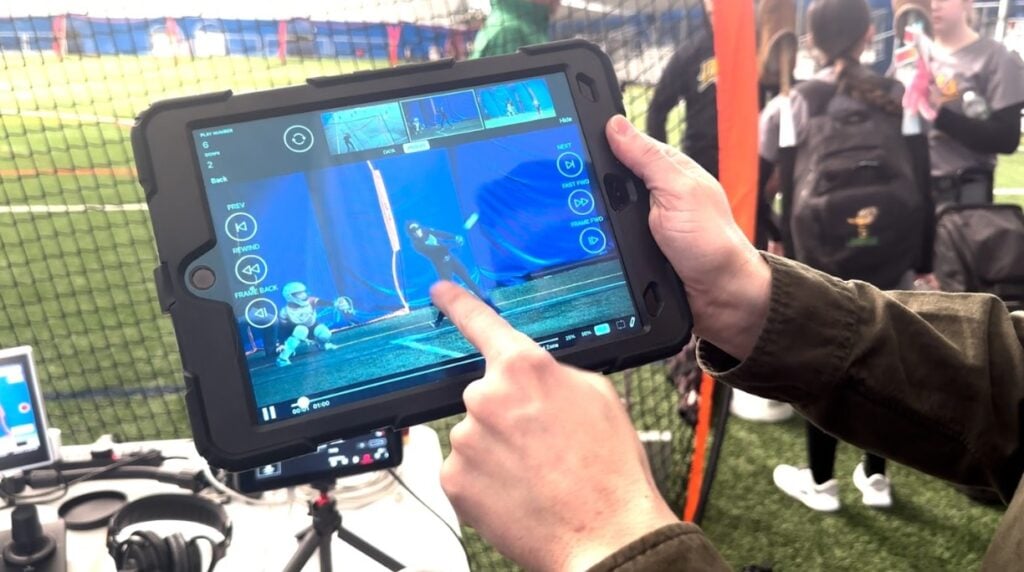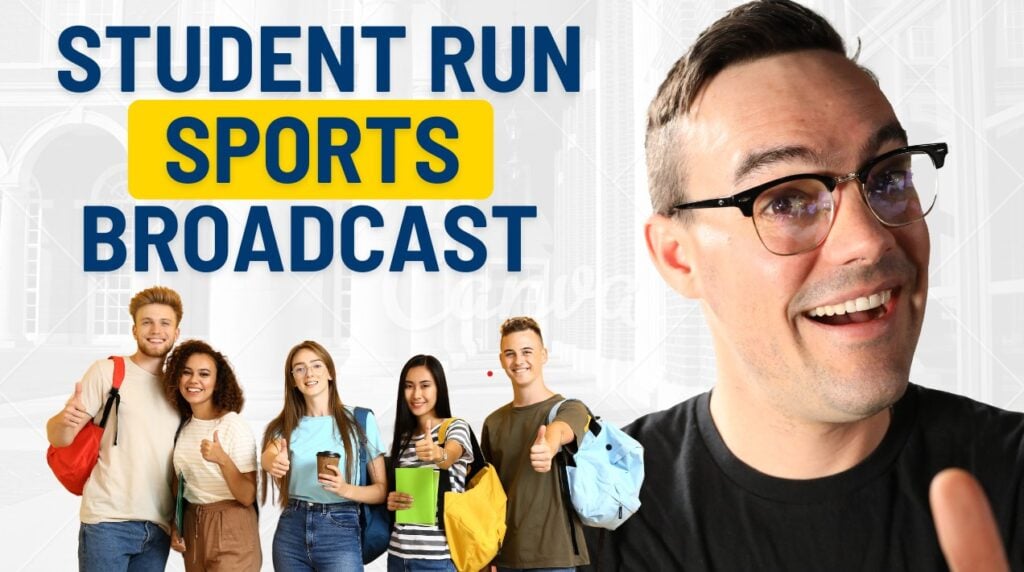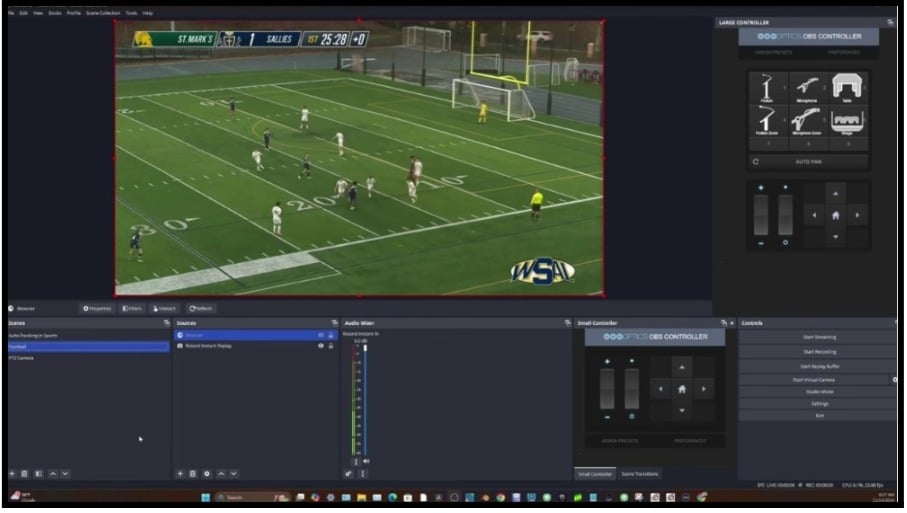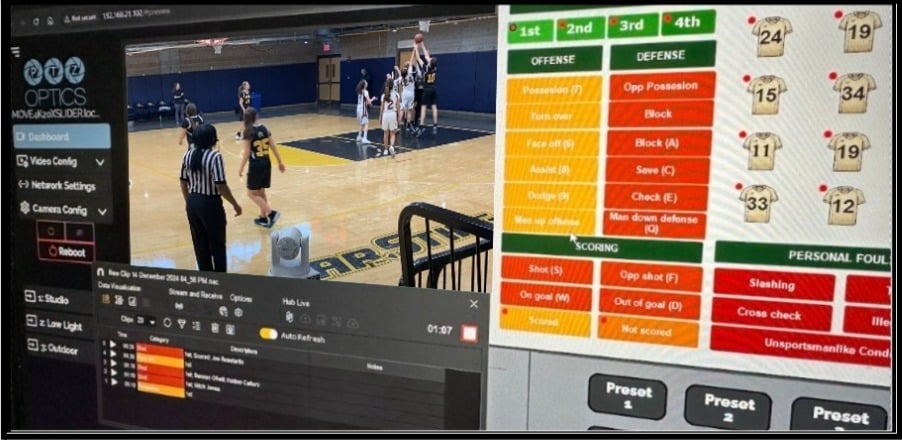How to make Sports Highlight Reels – Elevating Player Profiles – Chapter 6
Written by Paul Richards on February 18, 2025
As the sports world becomes increasingly digital, athletes now have unprecedented opportunities to shape their personal narratives and stand out to college recruiters, professional scouts and talent evaluators. No longer is it enough for a player’s talent to remain confined to a local field or court; with the right approach to video content creation, that talent can be shared with anyone, anywhere, at any time.
This is where coaches, analysts, educators and sports content creators have a crucial role to play. While players may be the stars on the field, they often need guidance and structure off it—especially when it comes to making their skills visible to scouts. A well-coordinated sports video program doesn’t just serve the needs of the team as a whole; it can also empower individual athletes to showcase their abilities in a polished organized fashion.
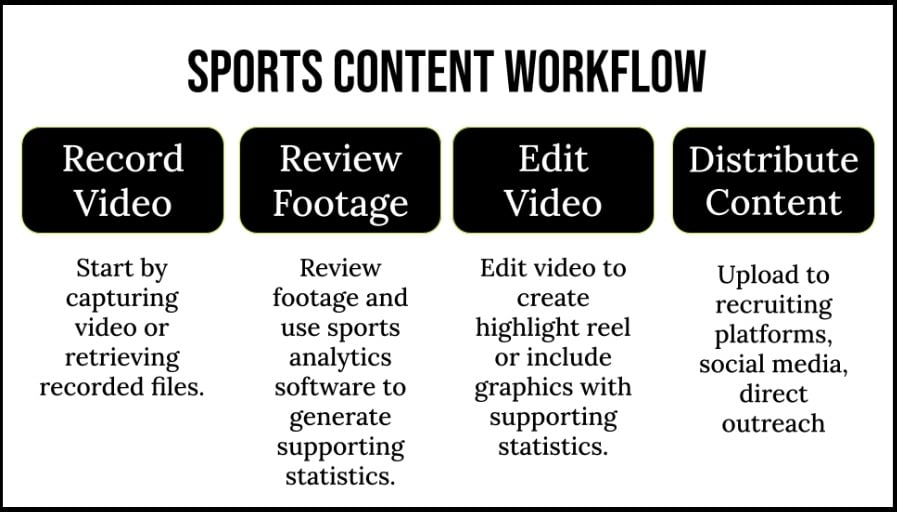
Sports Video Content Workflow
The Role of Coaches, Analysts, Educators and Content Creators in Supporting Player Showcases
Coaches and analysts understand what scouts look for in prospective recruits. They know that a highlight reel isn’t just about flashy goals or dramatic dunks; it’s about consistently good decision-making, strong fundamentals, versatility and steady improvement over time. Educators and academic advisors can also help highlight the student aspect of “student-athlete,” ensuring that videos feature not just athletic prowess but a player’s intellectual engagement, team leadership and academic discipline. Meanwhile, the sports content creation team can shape raw footage into compelling narratives: organizing camera coverage, selecting the best angles, editing for clarity and even incorporating analytics or graphics that underscore a player’s unique strengths.
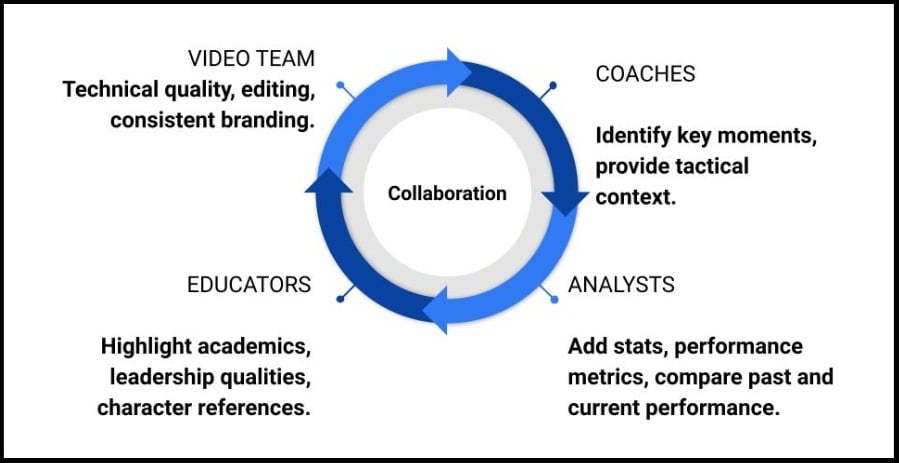
Coaches working with video teams
Together, these professionals create a support system that allows players to focus on what they do best—perform on the field—while a structured workflow transforms raw footage into a strategic scouting tool.
Why Player-Generated Content Matters: Personal Branding, Self-Promotion and Visibility to Scouts
For athletes aiming to continue their careers at the collegiate or professional level, personal branding has become an essential piece of the puzzle. While coaches and scouts still network through traditional channels, they increasingly rely on digital platforms—like recruiting websites, social media and video-sharing services—to discover new talent. A well-crafted highlight reel, combined with longer-form content that shows full games or training sessions, can give scouts a multifaceted understanding of a player’s skill set, athleticism and potential.
By taking an active role in producing their own content, players learn to present themselves professionally and strategically. Instead of leaving their futures solely in the hands of chance, they can proactively build a portfolio of performance clips, interviews and training footage. When these assets are expertly produced and thoughtfully curated, they resonate more strongly with scouts, who often sift through countless profiles and videos in search of the right candidate.
Here are some of the key piece of content players should create:
Highlight Reel
- Primary Purpose: Provide a quick, impactful overview of top skills and standout moments.
- Key Scout Takeaways: Immediate skill level, athleticism and game-changing abilities.
- Best Practices:
- Keep it short (2–3 minutes)
- Lead with strongest plays
- Clearly identify the player (e.g., arrows, spot shadows)
- Maintain high-quality visuals and stable footage
Full-Game Footage
- Primary Purpose: Show consistency, decision-making and how the player performs over an entire match.
- Key Scout Takeaways: Tactical awareness, off-ball movement, stamina, adaptability and mental resilience.
- Best Practices:
- Include offense, defense and transitional play
- Highlight critical match situations (pressure moments, end-of-game scenarios)
- Use stable, wide-angle shots for better context
- Ensure good lighting and camera placement
Training/Workout Clips
- Primary Purpose: Demonstrate commitment to improvement, work ethic and technical skill development.
- Key Scout Takeaways: Progress over time, dedicated training habits and willingness to refine technique.
- Best Practices:
- Show a variety of drills and exercises
- Document progression (before/after comparisons)
- Maintain consistent framing and clear angles
- Ensure adequate lighting and minimal background distractions
Intro/Interview Segment
- Primary Purpose: Showcase personality, communication skills, academic achievements and character.
- Key Scout Takeaways: Attitude, leadership potential, coachability, cultural fit within a team.
- Best Practices:
- Keep it concise and authentic (1–2 minutes)
- Maintain professional tone and attire
- Include simple graphics or captions for key info (GPA, honors, leadership roles)
- Ensure good audio quality and a quiet setting
How the Sports Video Team Can Facilitate Organized, High-Quality Player Content
A player’s raw talent is only as visible as the quality of the video that captures it. While automated, AI-enabled cameras can record games and follow the action at a basic level, these systems often provide just one angle and limited context. By contrast, a dedicated sports video team—comprising camera operators, content creators and editors—can produce richer, more dynamic footage. These professionals understand how to highlight the precise details scouts care about: footwork, positioning, off-ball movements and adaptability in various game situations.
Moreover, the sports video team can implement a workflow that makes it easy for players to request clips, share highlight reels and update their portfolios regularly. This might involve a cloud-based storage system for footage, a tagging system that identifies player involvement in key plays and direct collaboration with coaches and analysts to ensure the right moments are captured. Platforms like Hudl can simplify this process by providing tools for video analysis, tagging and sharing, while Krossover and VidSwap offer advanced features like play breakdowns and easy player-specific clip creation. For teams looking to streamline their process even further, Trace uses AI to automatically generate personalized highlight reels for each player, eliminating the need for manual sorting. Similarly, Veo employs AI tagging to identify key plays, making it a breeze to find and share standout moments. With such tools in place, the sports video team can ensure that the final products are not only polished and scout-ready but also delivered efficiently—no more scrambling through random files or low-quality phone recordings to find that perfect clip. These purpose-built platforms not only save time but also enhance the professionalism of the team’s media output.
By forming an alliance among coaches, analysts, educators and content creators, today’s sports programs can provide players with the tools and expertise they need to shine on camera. The result? Players who step confidently into the spotlight, prepared to impress scouts with not only their athletic ability, but also the strategic, skillfully presented content that tells their story.
Understanding Scout and Recruiter Priorities
When it comes to attracting the attention of scouts and recruiters, pure athletic ability is only part of the equation. While they certainly appreciate a hard swing of the bat, a lightning-quick sprint down the sideline or a perfectly placed free kick, those searching for the next generation of college athletes or professional prospects often look deeper. They’re hunting for well-rounded players who can excel in demanding environments, adapt to various game situations and contribute positively to a team’s culture—both on and off the field.
Highlight Reels for Quick Impressions
Highlight reels are a staple for any aspiring athlete looking to catch a scout’s eye. Short and engaging, these condensed videos should feature the player’s most impressive moments: goals, tackles, assists, saves or standout technical skills. The key is selectivity—quality over quantity. You can save yourself a lot of time editing video, if you know what you are looking for and notate it during the video recording. The easiest way to do this is scrub through the video timeline looking for scoreboard changes. Another way to quickly scan video for specific plays is to reference timing notes you took during the game.
Pro Tip: While AI tools can automate much of the highlighting process, learning how to edit a sports highlight reel in video-editing software allows you to get exactly what you are looking for. When the AI fails, consider how much time it would take to simply sit down and get the job done by hand.
Long Form to Short Form
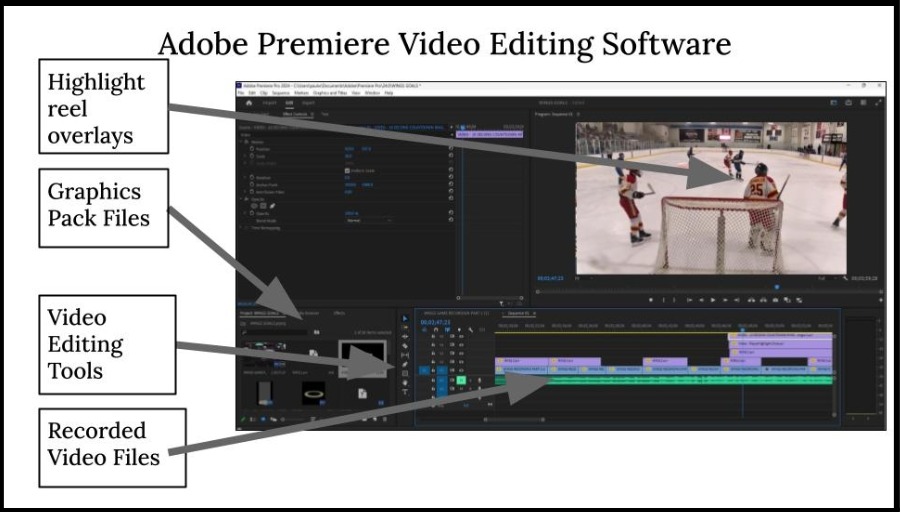
Video Editing Software for Sports Highlight Reels
Adobe Premiere is a commonly used video editing software which is used in the Sports Video online course. Once you have your entire game footage, it’s useful to break down smaller sections for your team, athletes and eventually scouts to review. Video editing can be outsourced to freelancers easily who can repackage “long form” content into more organized “short form” video.
Coaches often use these shorter video segments to focus on specific aspects of gameplay. For instance, a soccer coach might compile clips highlighting a striker’s positioning during goal-scoring opportunities or a basketball coach might create a reel showcasing a player’s defensive movements. These curated clips make it easier for athletes to focus on areas for improvement and refine their techniques. Additionally, such edits can serve as motivational tools, emphasizing an athlete’s strengths by showcasing their top plays.
For scouts, these clips are invaluable. A baseball coach might send scouts a video featuring a pitcher’s most effective strikeouts, complete with slow-motion analysis of their throwing mechanics. Similarly, a football coach might use game footage to create a highlight reel of a quarterback’s most strategic passes to attract college recruiters.
Video editing also plays a critical role in preparing for upcoming games. Coaches can dissect opponents’ strategies by creating breakdowns of key plays, such as a volleyball team’s service patterns or a hockey team’s power-play formations. These targeted videos allow teams to study their opponents in detail, adjust their strategies and execute game plans more effectively.
By leveraging tools like Adobe Premiere and engaging freelancers for editing, coaches can ensure their video resources are both professional and impactful.
In soccer, the possibilities for video compilations are vast, reflecting the diverse aspects of the game that coaches, players and analysts focus on. Here are some examples:
- Player-Specific Performance Reel Ideals
- A striker’s goal-scoring opportunities: Highlighting shots on target, off-the-ball movements to create space and positioning during set-pieces.
- A midfielder’s passing accuracy: Clips showing key passes, through-balls and long-ball distributions that led to goal-scoring chances.
- A defender’s tackling and interceptions: Moments where they successfully stopped counterattacks or won one-on-one duels.
- Tactical Analysis Clips
- Team shape during transitions: Show how the team moves from defense to attack or vice versa, focusing on maintaining width and depth.
- Pressing sequences: Highlight collective pressing efforts to win back possession high up the field.
- Set-piece strategies: Break down corner kicks, free kicks or defensive setups during dead-ball situations.
- Match Highlights for Review
- Goal analysis: Highlighting the buildup leading to goals, both scored and conceded, to assess what worked or went wrong.
- Missed opportunities: Clips focusing on moments where better decision-making could have resulted in a goal.
- Critical mistakes: Highlighting errors in positioning, passing or marking that led to opposition goals.
Free 4K Sports Video Graphics Pack
Included with this book is a Sports Video Graphics Pack, a free set of 4K graphics designed specifically for sports productions. Whether you’re crafting highlight reels in post-production or spicing up your live broadcasts, these professionally designed assets can elevate your video content to new heights.
What’s Inside
- Player Spotlight Rings: Draw attention to a specific athlete, perfect for replays and highlight reels.
- Countdown Shot Clock: Keep viewers informed with an on-screen countdown for basketball or other timed sports.
- Stinger Transitions: Add dynamic, branded transitions between replays and live camera angles.
- Scoreboard Template: Provide real-time score updates during live streams or post-production edits.
The pack includes finished video files ready for quick integration, as well as editable Adobe After Effects projects for teams that want full customization—swap in your team colors, logos or unique stylistic elements. You’ll also find tutorials on using these graphics with popular live video production software like OBS and vMix, as well as detailed instructions in the companion online course on Udemy.
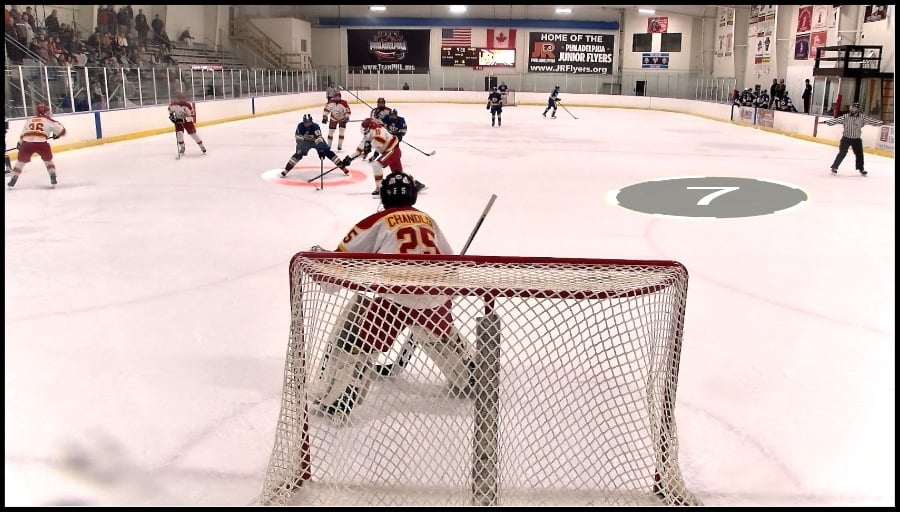
This picture shows one of the highlight rings video files available in the free graphics pack.
By incorporating these graphics into your highlight reels, you can add a professional look that helps your athlete stand out. With minimal time and effort, you can transform a simple clip compilation into a polished presentation—one that quickly communicates your player’s identity and skills to scouts, coaches or fans.
Personal Introductions and Soft Skills Videos
Lastly, consider including a more personal, human dimension. Short interview clips or self-narrated segments allow players to talk about their goals, academic interests, leadership experiences and the values they bring to a team. Educators can help shape this content, ensuring players articulate their commitment to academic excellence and community involvement, while coaches and content creators can guide them in presenting themselves confidently and authentically.
Scouts appreciate seeing who a player is beyond their stat line. Demonstrating communication skills, humility and an understanding of team culture can give a player an extra edge over similarly skilled athletes. When it comes to scholarships or choosing a recruit who fits into a program’s long-term vision, character matters just as much as talent.
By producing a range of content—highlight reels for instant impact, full-game footage for context, training clips for evidence of improvement and personal segments for character insights—players can present themselves as complete packages. Coupled with the organizational and technical support of coaches, analysts, educators and the sports video team, this multifaceted approach maximizes a player’s chances of making a powerful and lasting impression on scouts.
Involving the School’s Media Club, Broadcast Team or Volunteers to Ensure Quality Footage
Relying solely on a single stationary camera or an AI-driven system often limits the depth and nuance of your footage. Instead, consider tapping into existing resources. Many schools have a broadcast club or a student media team eager to gain real-world production experience. These budding videographers can handle multiple cameras, capture various angles and react dynamically to the flow of the game.
Volunteers—such as parents, alumni or even injured players looking to stay involved—can also lend a hand. With a brief training session, they can learn basic shooting techniques and positioning strategies. Over time, these contributors become part of the production ecosystem, ensuring a steady flow of high-quality, context-rich video.
Editing for Clarity and Efficiency
Good editing is about telling a cohesive story that respects both the viewer’s time and the player’s goals. Editors should start by organizing footage and identifying standout moments aligned with the player’s strengths. Cutting out dead time, irrelevant plays and repetitive actions keeps the narrative tight and engaging. Scouts are more likely to watch an entire highlight reel if it feels purposeful and well-paced.
Subtle graphics, such as player identification, stats overlays or branded bumpers, can lend a professional touch. Keep visuals clean and unobtrusive—scouts should never struggle to see the action because of cluttered screens. Captions or simple annotations can highlight key moments, such as “Excellent passing sequence” or “Demonstrated leadership under pressure,” reinforcing the narrative you want the viewer to remember.
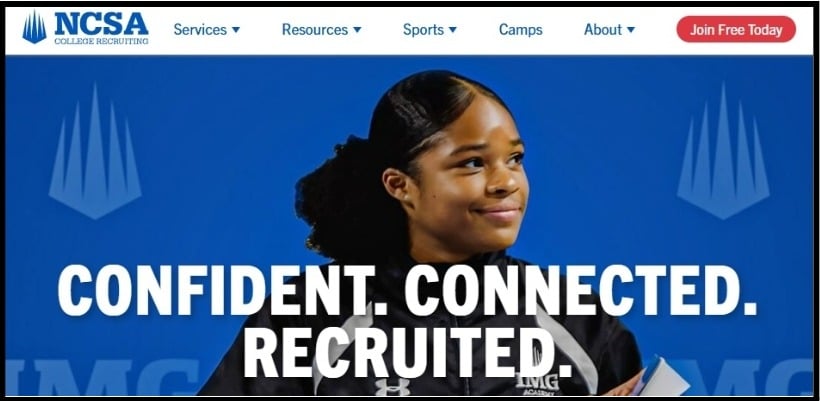
NCSA is a college sports recruiting solution.
Distribution Strategies for Maximum Visibility
Capturing and editing exceptional video content is only half the battle—making sure the right people see it is equally important. Scouts and recruiters navigate a sea of online profiles, highlight reels and social media posts in search of standout athletes. Purpose-built platforms like Hudl, widely used by teams and athletes, allow players to create polished highlight reels and share them directly with recruiters. NCSA (Next College Student Athlete) provides a comprehensive recruiting network where athletes can upload videos, manage their profiles and connect with college coaches. Similarly, BeRecruited focuses on providing a centralized space for athletes to showcase their skills and share videos with potential recruiters. FieldLevel, another recruiting platform, emphasizes collaboration between athletes, coaches and scouts to help players find the right opportunities. By choosing platforms like these, formatting content to suit various audiences and using direct outreach effectively, players and their support teams can ensure that their videos rise above the noise and reach the decision-makers who matter most.
Social Media Channels (Twitter, Instagram, YouTube, TikTok)
Modern scouting increasingly begins online, making social media a powerful tool for players. Platforms like Twitter and Instagram, with their strong sports communities, allow athletes to share short clips, training snippets and personal updates that build familiarity over time. YouTube offers a home for longer-format highlight reels and full-game footage, enabling scouts to dive deeper when something catches their eye. TikTok’s brief, high-energy format can be ideal for showing off a player’s speed, skill or personality in bite-sized segments.
Adapting content to each platform’s strengths is key. On Twitter, a concise highlight of a crucial play paired with an engaging caption and relevant hashtags can spark interest quickly. On Instagram, well-edited Reels and Stories keep content fresh and interactive. YouTube’s flexible format accommodates a player’s full portfolio, from highlight compilations to “day in the life” vlogs, demonstrating dedication and growth.
Incorporating Sports Photography to Elevate Player Profiles
As you seek to showcase the multifaceted talents of your student-athletes, video often takes center stage. It’s dynamic, immersive and offers a clear look at an athlete’s skills in real time. However, there’s another component that can make these profiles even stronger: sports photography. Beyond simply impressing college recruiters and scouts, still imagery can serve a broader range of audiences and purposes—think school newspapers, social media spotlights, personal keepsakes and promotional materials for the team.
The Versatility of Still Images
A single photo can capture an emotion or pivotal moment in a way that adds depth to an athlete’s story. While highlight videos are crucial, complementary still shots are often more shareable on social media, eye-catching in a school newspaper article or ideal for printing on posters and banners. Photos deliver a quick visual hook, encouraging viewers to learn more and engage with the athlete’s journey.
Extracting High-Quality Stills from Video
If you’re already recording games and practices in high resolution, you have an untapped resource for compelling photography. Most video editing software allows you to export individual frames as still images. Here’s how this adds value:
- Never Miss the Moment: Instead of relying on a single burst of photos from a dedicated camera, you can scan through your footage to pinpoint the exact split-second of a decisive play—whether it’s a last-minute goal or a gravity-defying jump shot.
Consistent Look and Feel: By extracting stills from the same camera that captures your video content, you ensure the images match the overall aesthetic of your highlight reels and team branding.
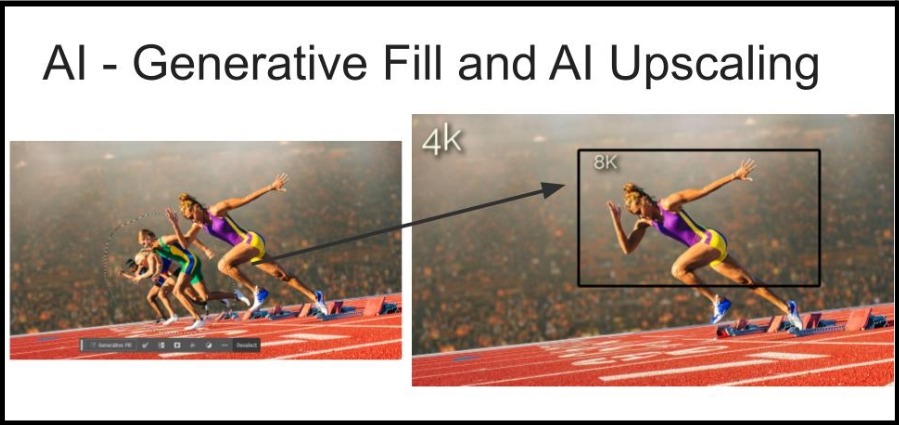
Editing photos has become much easier with generative fill and AI upscaling
Modern photo editing tools such as Adobe Photoshop, Lightroom, Topaz Photo AI and Gigapixel can significantly enhance the overall quality and presentation of your sports photography:
- AI Generative Fill
- Remove background clutter or distractions in a few clicks.
- Seamlessly fill in or extend parts of the image to highlight specific players and make each shot more engaging.
- AI Upscaling
- Perfect for creating large-format prints, banners or posters by enhancing resolution and clarity.
- Retain crisp details, even when enlarging an image well beyond its original size.
These AI capabilities ensure every still image—whether destined for a social media feed, a school newspaper spread or a player’s personal keepsake—looks polished and professional.
Benefits and Uses of Sports Photography
- Social Media Engagement
- Eye-catching photos on Instagram, Facebook or X (Twitter) quickly generate likes, shares and comments. Players, friends and family can repost and expand the team’s reach.
- School Newspaper and Yearbook Features
- High-quality images are essential for editorial pieces, player spotlights and end-of-season recaps. A striking photograph in the school paper can boost an athlete’s presence in the local community.
- Promotional and Branding Materials
- Photos can enhance flyers, banners and programs for upcoming games or special events. They also provide visually appealing content for websites and newsletters.
- Memorabilia and Personal Keepsakes
- Families and players often cherish professional-quality action shots. These photos become lasting memories and can help build an athlete’s personal brand.
- Highlight Reels with Complementary Stills
- Interspersing photographs within a video or adding them to thumbnails can draw attention to your highlight reels and provide a more comprehensive look at an athlete’s performance.
Sports-Specific Recruiting Platforms (Hudl, NCSA, MaxPreps)
While social media can attract a broad audience, sports-specific recruiting platforms cater directly to coaches and scouts. By maintaining a polished, up-to-date profile on services like Hudl, NCSA or MaxPreps, players put their best foot forward in virtual environments designed for talent discovery. Here, recruiters can easily view integrated stats, access practice footage and compare athletes against their peers.
Coaches, analysts and educators can assist players in filling out detailed profiles—highlighting academic achievements, test scores, volunteer experiences and other personal attributes that might appeal to college programs looking for well-rounded recruits. Scouts value the efficiency of these platforms: they can filter based on position, level of competition and key performance metrics, ensuring that a well-maintained profile is never lost in the shuffle.
Direct Communication with Recruiters and Coaches
Even with well-optimized social media profiles and recruiting accounts, direct outreach still holds significant power. Sending personal emails with a brief introduction, key highlights and links to highlight reels allows players to control their narrative. Coaches and analysts can guide athletes on crafting professional, concise messages that emphasize strengths, character and fit with the target program. Including contact information for references—like a head coach or a mentor—further bolsters credibility.
Timing and follow-through matter. Sending highlight reels after a strong performance, along with a short note summarizing the player’s recent improvements, can keep scouts engaged. A polite follow-up, if initial contact goes unanswered, demonstrates persistence and organization—traits that often translate well onto the field.
By strategically distributing video content across social media platforms, recruiting websites and direct communication channels, players expand their visibility and increase the likelihood of connecting with the right recruiter. Coaches, analysts, educators and content creators all have roles to play: guiding platform selection, curating content length and style and helping players present themselves professionally. With a smart distribution plan in place, the countless hours spent recording, editing and organizing video don’t go to waste—they become stepping stones toward scholarships, roster spots and the next stage in a player’s athletic journey.
Collaboration Unlocks the Future
Crafting player-focused video content that impresses scouts isn’t a solo endeavor. It’s a team effort that draws on a range of expertise, from on-field strategy to video production and academic mentorship. Sports video platforms such as Hudl are making it easier to make video accessible directly to athletes, coaches and scouts. When coaches, analysts, educators and content creators come together with a shared goal, they ensure that each athlete’s footage not only looks good but also tells a compelling, well-rounded story.
Coaches: Identifying Key Moments and Providing Tactical Insights
Coaches know their players best—where they excel, where they need improvement and what moments in a game truly reflect an athlete’s potential. By working closely with the video team, coaches can specify which plays deserve the spotlight. They can highlight a midfielder’s improved passing accuracy, a defender’s positional awareness or a forward’s off-ball movement that opens space for teammates. This tactical direction ensures that every clip in a highlight reel or full-game analysis is purposeful, underscoring strengths that scouts value.
Beyond the technical side of the sport, coaches can share insights into a player’s work ethic, attitude and coachability. This may seem like a lot for an already busy coach to handle, but new sports video tools are making it easier to share responsibility for accessing and creating sports video for these use cases.
Analysts: Integrating Data and Performance Metrics
Analytics add depth and credibility to a player’s profile. Analysts can supplement raw footage with metrics like pass completion percentages, defensive clearances, shot accuracy or sprint speeds. Visual aids—heat maps, possession stats and comparison charts—can appear as simple, integrated graphics during key sequences.
This data-driven approach appeals to scouts who appreciate evidence that a player’s impact goes beyond what the naked eye can see. Contextualizing a highlight reel with performance metrics transforms it from a “best-of” compilation into a nuanced analysis tool, showing steady improvement, reliability under pressure and the ability to influence the game in measurable ways.
Educators (Teachers, Academic Advisors): Highlighting Academic and Personal Traits
For collegiate recruiters, academic performance and personal maturity often matter just as much as athletic skill. Educators can contribute by recommending which honors, grade point averages or extracurricular activities to feature in a player’s profile. They might also suggest including brief interviews where the athlete discusses balancing schoolwork with training, illustrating responsibility and time management skills.
By collaborating with educators, the video team can incorporate a player’s academic achievements into their highlight package or online profile. A player who can handle rigorous coursework while excelling on the field demonstrates that they’re ready for the demands of collegiate life, increasing their appeal to college programs.
The Sports Video Team: Coordinating Efforts, Maintaining Production Quality and Ensuring Timely Delivery
The sports video team plays the crucial role of orchestrating all these inputs. They listen to coaches’ tactical insights, incorporate analysts’ statistics and integrate educators’ recommendations, all while maintaining a high standard of production quality. With clear communication channels and defined workflows, the team ensures that raw footage moves smoothly through the pipeline—from initial capture, to refinement, to final delivery.
They also manage scheduling: setting deadlines for editing, review sessions with coaches and feedback from educators or analysts. This coordinated approach helps prevent last-minute scrambles and ensures that players receive their updated highlight reels or full-game packages well before any scouting deadlines.
In a well-coordinated system, coaches sharpen the storytelling with athletic insights, analysts enrich it with data, educators elevate it with academic context and the sports video team stitches it all together into polished, professional content. Such collaboration doesn’t just produce better videos—it ensures that players are presented as whole individuals, balancing athletic prowess with intellectual promise and character strengths. The result is a player profile that resonates more deeply with scouts, improving the athlete’s chances of landing scholarships, roster spots and other career-advancing opportunities.
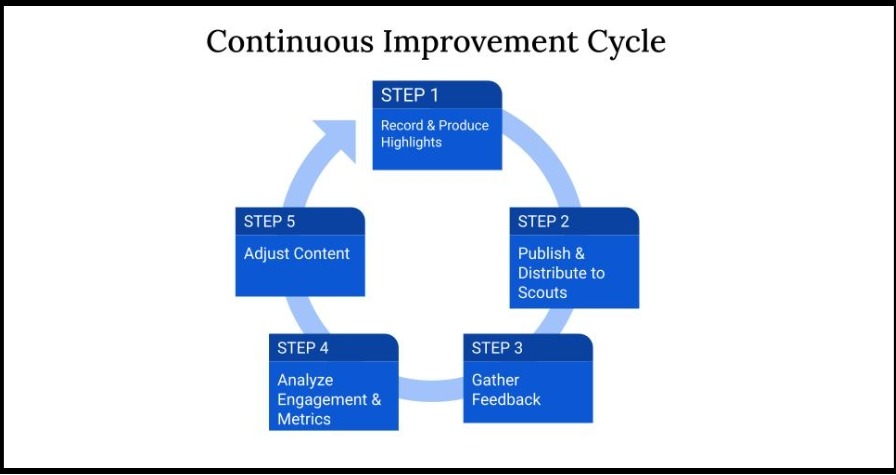
Continuous Improvement and Review
Even the most polished highlight reel or perfectly curated video profile isn’t a one-time effort. Athletic performance is dynamic—players evolve, gain experience and refine their skills season after season. Similarly, the process of producing, sharing and leveraging video content for recruiting success should remain fluid and adaptable. By embracing feedback, monitoring results and adjusting strategies accordingly, players and their support teams can ensure that their content remains relevant, persuasive and aligned with their long-term goals.
Gathering Feedback from Trusted Advisors—Coaches, Mentors, Recruiters
One of the most valuable steps after sharing highlight reels and full-game footage is seeking constructive criticism. Coaches can identify areas where footage could better reflect tactical growth. Mentors and former players, who have navigated the recruiting process themselves, can offer insights on what resonated with scouts during their own experiences.
In some cases, players may receive direct or indirect feedback from recruiters. While not always possible, when a scout does share thoughts—perhaps praising certain angles, pointing out missing elements or noting that they’d like to see more defensive plays—it’s an invaluable opportunity to fine-tune the approach. Incorporating this input quickly can turn a “maybe” into a “yes” down the road.
Monitoring Engagement and Interest: Views, Inquiries and Communication from Scouts
Digital platforms make it easier than ever to track engagement. By monitoring views, likes, shares, comments and direct inquiries from coaches or scouts, players and their support teams gain tangible data on what’s working and what’s not. For instance, if full-game footage consistently garners more interest than a sizzle reel or if certain types of plays spark conversations with recruiters, that information can guide future content decisions.
This ongoing evaluation transforms video production from guesswork into a data-driven practice. Just as analysts use performance metrics to measure on-field improvement, the video team can measure off-field success by how often scouts respond, request additional footage or invite a player for in-person evaluations.
Adjusting Content Based on What Resonates with Scouts
The sports landscape is always shifting. A year ago, a player’s long-range shooting might have been their greatest strength; now, their defensive tenacity or playmaking ability might steal the show. As players mature, improve technique and maybe even change positions, their video content should reflect these developments.
If feedback suggests scouts want to see more complete matches or more evidence of leadership qualities, incorporate those elements in the next set of highlights. If the data shows that short clips on social media generate more engagement than full YouTube compilations, prioritize quick-hit, high-impact content. Flexibility and responsiveness help ensure that each new iteration of content is more aligned with recruiter expectations than the last.
Encouraging Players to Reflect on Their Growth and Update Highlights Each Season
Players shouldn’t view video content as something created once and forgotten. Regular updates—each season, at the midpoint of a tournament or after a significant improvement in a key skill—keep content fresh and ensure that scouts always see the athlete’s current level of performance.
Reflection is a powerful tool. By reviewing their own footage, players develop self-awareness about their strengths and areas for improvement. They learn what scouts find compelling and can target those aspects in their training. This mindset transforms video production into a cycle of growth: athletes film, analyze, train, improve and then film again—each cycle building toward a more complete, more convincing athletic profile.
By embracing continuous improvement, players and their support teams transform video production from a static task into an evolving strategy. Through feedback, data-driven adjustments and regular content refreshes, they ensure that every highlight reel, every training montage and every full-game breakdown increasingly reflects the player’s best and most relevant attributes. The result is a dynamic, ever-improving portfolio that continues to engage scouts, inching players closer to the scholarships and opportunities they’ve worked so hard to earn.
Join the StreamGeeks Community and Start Streaming Like a Pro By downloading Sports Video: Recording, Analysis, and Live Streaming, you’ll gain access to:- Proven techniques for live production success.
- The tools to engage and grow your audience.
- Insights that will transform your approach to live video.
Download Sports Video Here
You can purchase the paperback here. <>Sports Video Chapters
- Download Sports Video here
- Chapter 1: Intro to Sports Video here
- Chapter 2: The Power of Sports Video here
- Chapter 3: Recording Sports Video here
- Chapter 4: Sports Video Analytics here
- Chapter 5: Using wide angle tactical cameras for sports video here
- Chapter 6: How to make sports highlight reels here
- Chapter 7: Sports Video Essentials Level 1 here
- Chapter 8: Portable Sports Video Systems here
- Chapter 9: Sports Video Analytics Systems here
- Chapter 10: How to Live Stream Sports Like a Pro here
- Chapter 11: Setting Up Cameras and Sports Equipment for Different Sports here

